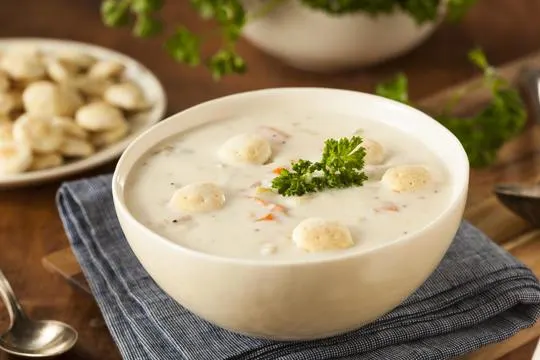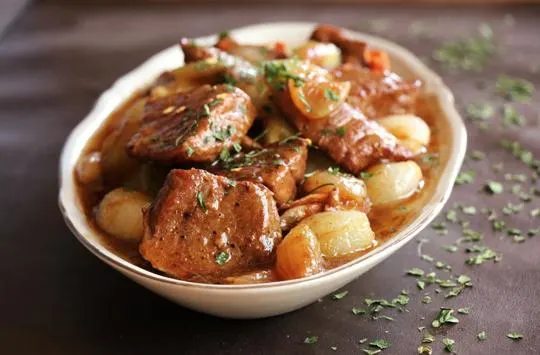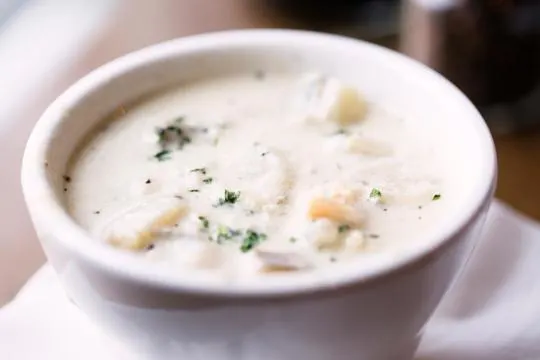Ever tried figuring out the fine line between stew, soup, and chowder? Yeah, it’s a bit of a kitchen conundrum.
Soup is like the casual, liquidy comfort food we all lean on. Stew? It thickens the plot with less broth and more hearty chunks. Then there’s chowder – a creamy, dreamy cousin with a seafood or corn base, making our spoons happy.
We’ve all been there, stirring the pot, pondering what makes each dish unique. No two soups (or stews, or chowders) are quite the same, a culinary puzzle that keeps us coming back for more.
Our own misadventures in trying to nail the perfect bowl of whatever-it-was-supposed-to-be have taught us a thing or two. Ready to dive in?
What is Stew?

Stew is a cozy dish. It’s made by cooking meat and veg in liquid for ages.
The ingredients are usually chopped into small pieces and cooked in a thick sauce.
This gives it a great taste. It’s often made with tougher cuts of meat.
Cooking slowly breaks down the muscle fibers, making it tender and yummy.
Stew can be comforting, warming and full of flavour – perfect for cold winter nights or after a long day.
Stews can be eaten alone or used as a base for other dishes.
Leftover stew can be wrapped in pastry to make pasties, or put on pasta or rice.
Popular stews include beef, chicken, lamb and veggie.
Whatever your preference, a bowl of stew is sure to fill you up.
Stews are great for stretching your food budget.
By mixing scraps of meat and veg with stock, you get a nutritious and cheap dish.
You can customize stews to suit dietary restrictions.
It’s ideal for families with different tastes and needs.
If you want a tasty meal that’s easy to make, look no further than stew.
Its aroma and texture have been pleasing people for centuries – and will keep going for many more.
What is Soup?

Soup – a liquid dish with veggies, meat, or fish cooked in stock or water.
Usually served as a starter or main, it can be thin or thick with a range of flavors and textures.
Creamy, brothy, spicy, tangy, sweet, or savory – all types of soup available.
Chicken noodle, tomato, minestrone, French onion – just a few popular types.
Making soup is easy – boil ingredients in a pot until cooked through and flavorful.
Soup consistency is different from stews and chowders – thinner than stew, thicker than broth.
Plus, it’s great as a base for other recipes like casseroles and sauces.
And it’s healthy too. Full of veggies and lean proteins like chicken and tofu.
Soup is versatile. Tons of variations across cultures.
Truly, one of the most versatile dishes.
What is Chowder?

When it comes to soups, stews and chowders, chowder stands out.
The name “chowder” comes from the French word ‘chaudière’, which means a pot.
Chowder often has fish or shellfish like clams, shrimp, or lobster.
Plus, it has vegetables like potatoes and onions for flavor and texture.
Chowder is thick and creamy.
This happens because it uses roux, which is a mix of fat and flour.
Some variations use cornstarch or blended veggies instead.
Distinguishing Factors: Stew, Soup, and Chowder

Are you a food lover? It’s essential to know the difference between stew, soup, and chowder to truly enjoy your meal.
All have cooking ingredients in liquid.
But, each has its own unique characteristics.
1 – Ingredients and Texture
Soups, stews, and chowders may seem similar.
But, they have real differences.
Soup is thin and usually made up of veggies, meat, or grains.
Stews have a thicker texture due to more cooking time and tougher cuts of meat.
Chowders are creamy with ingredients like potatoes, fish, or shellfish.
Recipes for these dishes change based on where it is from and what ingredients are available.
There are no hard rules for preparing them.
Some can blur the line between them using different techniques or ingredients.
For example, seafood stews can resemble chowders with their creamy consistency, while still having a heartier texture than soup.
It’s up to personal preference when choosing between soups, stews, and chowders.
Consider what type of meal you want when deciding.
Soup is light and filling.
Stews are comforting and hearty.
Chowders are creamy and contain chunks of seafood or potatoes.
2 – Cooking Method and Duration
Cooking? It’s all about the method and the time.
Knowing the difference between stew, soup, and chowder can make you a better cook and make yummier meals.
Here’s a guide to help you out:
- Stew: Low heat for a few hours. Cut the ingredients small and cook them in liquid until tender. This helps make flavors mix.
- Soup: Boil, steam, or simmer. Less cooking time than stew. Broth-like consistency.
- Chowder: Creamy due to dairy products like milk or cream. Chunky pieces of seafood like clams or fish and veg like potatoes.
- Duration: Stews=long. Soups=up to an hour. Chowders=30-40 mins due to pre-cooked ingredients.
- Method: Stews=all ingredients at once in a pot. Soups=add gradually and reduce heat before simmering. Chowders=careful not to boil or else it’ll curdle.
Remember, these dishes all have differences.
Knowing them can help you get the best results.
3 – Broth or Base
Broths are the foundation for delicious soups, stews & chowders.
They don’t need chunky ingredients, but rather a flavorful liquid made by simmering meat, vegetables & aromatics.
Broths are versatile & pair well with different dishes & cuisines.
Clear broths are ideal starters, while heartier versions with beef or chicken bones make a great main course.
Plus, they’re simple & easy to make at home, making them perfect for adding flavor to dishes.
In conclusion, broths are key for making soups, stews & chowders.
They stand out due to their versatility & are an excellent option for cooks looking to add flavor to meals.
So, next time you’re cooking soup or stew, try starting with a flavorful broth.
4 – Consistency and Thickness
Stews, soups and chowders are all different in terms of their consistency and thickness.
Here’s what makes them unique:
- Stews have a thick, sauce-like texture and include large chunks of meat and veggies cooked to perfection.
- Soups are thinner than stews and made with a clear broth. They don’t usually have big chunks of meat or veggies.
- Chowder is a thick soup made with milk or cream. It contains potatoes, onions and seafood like clams or fish.
- Stews are great for chilly weather because they’re filling. Soups are perfect for light meals or lunch.
- Chowders are heartier than soup but less dense than stew.
- Lastly, soups can be served hot or cold, while stews and chowders are only served hot.
Knowing these distinctions can help you decide which dish to make or order.
Regional Variations of Stew, Soup, and Chowder

Stews, soups and chowders are popular dishes all around the world.
But their regional variations give each one a unique taste.
Stews are found in Europe and North America.
They are made with meat, vegetables and potatoes cooked in a sauce or broth.
Soups are eaten globally.
They can be hot or cold and are made by boiling ingredients in either water or broth.
Chowders are mostly found on the East Coast of the US, especially in New England.
They are made with seafood, vegetables such as corn or potato, milk or cream and sometimes crackers.
Stews use locally available ingredients.
For example, Hungarian goulash has sausages and Irish stew has beef.
Cuisines also influence stews.
Spanish Cocido uses chickpeas and Moroccan Tagine has lamb with dried fruits and nuts.
Italian Minestrone is a famous soup.
It has vegetables such as carrots, celery and tomatoes.
It also has pasta shells.
Beef stock can add flavor to it.
Chinese chicken soup has ginger and mushroom knuckles.
Chowders come in many varieties.
Lobster Chowder from Maine has chunks of lobster.
Clam Chowder from Massachusetts has clams seasoned with salt pork/bacon/pancetta and a milk-based soup form.
These dishes offer different flavors based on their location and culture.
Try them all to experience unique tastes.
When to Choose Stew, Soup, or Chowder?
Deciding between stew, soup, or chowder can be tough.
But, understanding the differences will help you pick the right dish.
Stew is a thick dish with meat, veg, and a liquid to simmer in.
Soups are thinner and often include more broth.
Chowder is creamy and can use clams, fish, or something else.
When picking a meal, think about what ingredients you have in your kitchen.
Stews are ideal when using up leftovers.
Soups work with any veg or protein.
Chowder offers a rich taste, perfect for special occasions.
Stew is good for colder months or when unwell.
Soups have nutritional benefits with less oil.
Chowders offer richness and elegance, great for dinner parties.
It may be tricky to choose between the three.
But, knowing what you want from your meal will help you explore new flavors.
In a nutshell, stew is hearty, soup is light, and chowder is creamy.
Common Ingredients Used in Stews, Soups, and Chowders
Stews, soups, and chowders are popular dishes across many cultures.
Each one has its own unique taste and texture.
Common ingredients include: Meat or vegetables, stock or broth, and herbs and spices.
Stew might have large chunks of meat or veg, cooked for hours.
Soups have smaller pieces and broth as their base.
Chowders contain seafood, potatoes, and corn.
They use milk or cream instead of stock.
Different herbs and spices are added for flavor.
Thyme, bay leaves, rosemary, and oregano for stews.
Basil, parsley, cilantro, and ginger for soups.
Chowder has pepper flakes or paprika for a bit of heat.
These ingredients are important, as they contribute to the unique flavors of each dish.
Conclusion
Stew, soup, and chowder are all comfort foods – each with a unique character.
Stew is thicker and heartier, soup is thinner, and chowder is creamy and contains chunks of meat or veg.
Stews need more cooking than soups or chowders.
This article explains the differences between stew, soup and chowder to help readers decide which one to order.
Each dish also has a fascinating history. Soups have been around for centuries.
The 17th century French chef La Varenne described it as a liquid with meat or veg cooked in water with minimal seasoning.
Stews were created to preserve food during winter, when fresh ingredients were not available.
Chowders were a French coastal dish, but they are now popular in North America with many variations such as fish, clams, chicken or corn.

Leave a comment